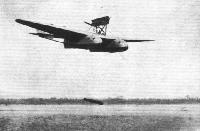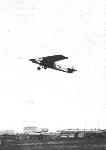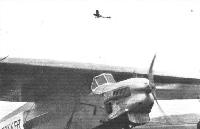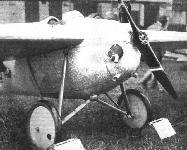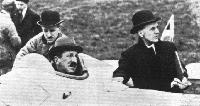Фотографии
-
A New Fairey 3D: Produced originally as a seaplane, in which form it was used by Wing-Commander Coble for his round-Australia flight, the Fairey 3D is also used as a land machine, in which guise it is shown in our photograph. A special Fairey oleo undercarriage is fitted. The engine is a Napier "Lion."
Самолёты на фотографии: Fairey Fairey III - Великобритания - 1917
-
Three-quarter front view of the Savoia S.55 torpedo and mine-laying mono-seaplane with twin boats and tandem engines (400 h.p. Lorraine-Dietrich).
Самолёты на фотографии: Savoia-Marchetti / SIAI S.55 - Италия - 1924
-
The Savoia S.55 twin-boat mono-seaplane in flight, launching its torpedo.
Самолёты на фотографии: Savoia-Marchetti / SIAI S.55 - Италия - 1924
-
Savoia S.55 Torpedo Seaplane Two 400 hp Lorraine-Dietrich Engines
Самолёты на фотографии: Savoia-Marchetti / SIAI S.55 - Италия - 1924
-
The Fokker F.VII, Napier "Lion," taking off for one of its demonstration flights.
Самолёты на фотографии: Fokker F.VII / C-2 / F.XIV - Нидерланды - 1924
-
The Fokker F.VII: Three-quarter front view. The engine is a Napier "Lion."
Самолёты на фотографии: Fokker F.VII / C-2 / F.XIV - Нидерланды - 1924
-
The Fokker F.VII: On the left, the nose, showing neat cowling. The undercarriage is of special design, and gives a very wide track. On the right, the control surfaces, which are of perfectly normal shape and size. The horn balance of the aileron is not of symmetrical section, but has flat bottom camber.
Самолёты на фотографии: Fokker F.VII / C-2 / F.XIV - Нидерланды - 1924
-
Mijnheer Fokker standing by his non-stalling monoplane.
Самолёты на фотографии: Fokker F.VII / C-2 / F.XIV - Нидерланды - 1924
-
Stalled flight:Bulman on the Avro, flying stalled above the Fokker monoplane.
Самолёты на фотографии: Avro Avro 504 - Великобритания - 1913Fokker F.VII / C-2 / F.XIV - Нидерланды - 1924
-
Регистрационный номер: H-NACR THE LATEST FOKKER F.VII: Fitted with a Napier "Lion" engine; this machine carries 10 passengers.
Самолёты на фотографии: Fokker F.VII / C-2 / F.XIV - Нидерланды - 1924
-
The Fokker F.VII: Three-quarter rear view.
Самолёты на фотографии: Fokker F.VII / C-2 / F.XIV - Нидерланды - 1924
-
IN THE FOKKER F.VII: This view inside the cabin gives a good idea of the seating arrangement, etc. Owing to the high position of the monoplane wing, the passengers' view is particularly unrestricted.
Самолёты на фотографии: Fokker F.VII / C-2 / F.XIV - Нидерланды - 1924
-
Fokker F.VII Napier "Lion" Engine
Самолёты на фотографии: Fokker F.VII / C-2 / F.XIV - Нидерланды - 1924
-
Three-quarter front view of the Savoia S.16ter, a bombing and reconnaissance flying boat fitted with a 400 h.p. Lorraine-Dietrich engine.
Самолёты на фотографии: SIAI S.16 / S.53 - Италия - 1919
-
Savoia S.16t Bombing Flying Boat 400 hp Lorraine-Dietrich Engine
Самолёты на фотографии: SIAI S.16 / S.53 - Италия - 1919
-
Flight-Lieut. Bulman on the slot-wing Avro doing a stalled turn without going into a spin. This performance is, of course, one which, in a "normal" machine would almost inevitably provoke a spin, but the Avro fitted with the slot-aileron combination showed no tendency to "autorotate." We understand that some time previously Flight-Lieut. Bulman put the machine into a stalled turn, and then stopped his engine "just to see what would happen." Nothing did happen, the machine remaining under perfect control.
Самолёты на фотографии: Avro Avro 504 - Великобритания - 1913
-
Slots and ailerons: Mr. A .V. Roe explains to his youngest son the action of the Handley Page slots on the Avro 504.
Самолёты на фотографии: Avro Avro 504 - Великобритания - 1913
-
Регистрационный номер: J6984 The first P.25 Bugle prototype, J6984, outside the hangars at Mousehold.
Самолёты на фотографии: Boulton Paul P.15 Bolton / P.25 Bugle - Великобритания - 1922
-
Регистрационный номер: J6985 THE BOULTON AND PAUL "BUGLE": Three-quarter rear view.
Самолёты на фотографии: Boulton Paul P.15 Bolton / P.25 Bugle - Великобритания - 1922
-
THE BOULTON AND PAUL "BUGLE": The tail skid and one undercarriage leg. Both are of the oleo-pneumatic type. The small inset shows, in section, the arrangement of the air-pressure gauge which can be put in series or out by means of the needle valve. The gauge is, of course, in communication with the air in the leg during the process of pumping-up only, or when inspecting the pressure in the leg.
Самолёты на фотографии: Boulton Paul P.15 Bolton / P.25 Bugle - Великобритания - 1922
-
THE BOULTON AND PAUL "BUGLE": 1, details of fuselage construction. 2, the construction of the special inter-plane struts, whose main structure is of metal, while the removable fairing is of three-ply wood. 3, a wing spar section, and, 4, a very light tip-up seat in the forward gunner's cockpit.
Самолёты на фотографии: Boulton Paul P.15 Bolton / P.25 Bugle - Великобритания - 1922
-
THE BOULTON AND PAUL "BUGLE": Side and front elevations and plan of tubular engine structure for mounting the Bristol "Jupiter" engines. The actual engine mountings in front are arranged to swivel so as to facilitate inspection of the back of the engines.
Самолёты на фотографии: Boulton Paul P.15 Bolton / P.25 Bugle - Великобритания - 1922
-
Boulton & Paul "Bugle" 2 Bristol "Jupiter" Engine
Самолёты на фотографии: Boulton Paul P.15 Bolton / P.25 Bugle - Великобритания - 1922
-
THE LOENING AMPHIBIAN BIPLANE: A recent American machine of somewhat unusual design, which might be described as being midway between the orthodox tractor-fuselage biplane and the flying-boat. It is fitted with a 400 h.p. Inverted "Liberty" engine.
Самолёты на фотографии: Loening OL / OA - США - 1923
-
The Fokker C.VI is an artillery-spotter (two-seater), with Hispano-Suiza engine.
Самолёты на фотографии: Fokker C.V / C.VI - Нидерланды - 1924
-
Регистрационный номер: G-EBKD [2] The Blackburn "Bluebird": In this view the undercarriage and the engine cowling, etc., are clearly shown. Note the Fairey-Reed Duralumin propeller.
Самолёты на фотографии: Blackburn Bluebird / L.1 - Великобритания - 1924
-
Регистрационный номер: G-EBKD [2] THE BLACKBURN "BLUEBIRD" LIGHT 'PLANE: Three-quarter rear view. Note the door giving access to the cockpit.
Самолёты на фотографии: Blackburn Bluebird / L.1 - Великобритания - 1924
-
Регистрационный номер: G-EBKF SCHOOL WORK AT BROUGH: These photographs, secured on a recent visit to the North Sea Aerial and General Transport Company's station show the Blackburn "Dart" seaplane, fitted with Napier "Lion" engine, which is used for seaplane training. It should be noted that a though the machine is not an amphibian in the usual sense of the term, the landing-wheels are carried on board, but are raised clear once the machine has taken the sea. They are lowered for transport on land and in launching and coming in. The upper left-hand photograph shows the "Dart" taking off, piloted by Mr Woodhouse and in the lower right-hand picture it is seen alighting. The other photographs are self-explanatory.
Самолёты на фотографии: Blackburn Swift T.1 / Dart T.2 - Великобритания - 1920
-
H.R.H. THE INFANTE DON ALFONSO OF SPAIN VISITS THE GLOUCESTERSHIRE AIRCRAFT COMPANY: The photo shows the Infante Don Alfonso inspecting the Siddeley "Jaguar" engine of a Gloucestershire "Grebe."
Самолёты на фотографии: Gloster Grebe - Великобритания - 1923
-
Three-quarter rear view of the Curtiss "Carrier Pigeon," 400 h.p. "Liberty."
Самолёты на фотографии: Curtiss Carrier Pigeon / Model 40 - США - 1925
-
The Curtiss "Carrier Pigeon": One of the latest products of the Curtiss company, specially designed for overnight air mail work. It is fitted with a 400 h.p. "Liberty" engine, and has a speed range of 50 to 120 m.p.h.
Самолёты на фотографии: Curtiss Carrier Pigeon / Model 40 - США - 1925
-
Side view of the Savoia S.57 fast reconnaissance flying boat fitted with a 300 h.p. Hispano-Suiza engine.
Самолёты на фотографии: Savoia-Marchetti / SIAI S.57 / S.58 / S.59 - Италия - 1923
-
Savoia S.57b Reconnaissance Flying Boat 300 hp Hispano-Suiza Engine
Самолёты на фотографии: Savoia-Marchetti / SIAI S.57 / S.58 / S.59 - Италия - 1923
-
Регистрационный номер: H-NACO [2] THE PANDER LIGHT MONOPLANE AT CROYDON: This side view gives a good idea of the size of the machine.
Самолёты на фотографии: Holland (VIH) H.2 - Нидерланды - 1924
-
The Undercarriage of the Pander light monoplane, and the neat engine cowling around the Anzani engine.
Самолёты на фотографии: Holland (VIH) H.2 - Нидерланды - 1924
-
The Pander Light Monoplane at Croydon: The Air Ministry is interested. General Brancker (in situ), on the right Major Buchanan, and behind Col. Darby, with a watching brief.
Самолёты на фотографии: Holland (VIH) H.2 - Нидерланды - 1924
-
The Pander monoplane coming in to alight after a flight at Croydon, and, inset, a photograph of the machine flying upside-down.
Самолёты на фотографии: Holland (VIH) H.2 - Нидерланды - 1924
-
Регистрационный номер: H-NACO [2] THE PANDER LIGHT MONOPLANE WITH ANZANI ENGINE: Three-quarter rear view.
Самолёты на фотографии: Holland (VIH) H.2 - Нидерланды - 1924
-
Регистрационный номер: A-10 The "Avis" B.S.I: Side view.
Самолёты на фотографии: Avis BS - Австрия - 1924
-
Регистрационный номер: A-16 The Avis B.S.II is similar to B.S.I, but the two cockpits are not separated, and the engine cowling is slightly different.
Самолёты на фотографии: Avis BS - Австрия - 1924
-
TWO AVIS SCHOOL MACHINES: The B.S.II is fitted with a 100 h.p. water-cooled engine, and the B.S.IV with an 80 h.p. Siemens radial air-cooled engine. General arrangement drawings.
Самолёты на фотографии: Avis BS - Австрия - 1924
-
A MILITARY FOKKER MONOPLANE: The D.XIV was put through its test flights at the Schiphol aerodrome last weak. Note the wide undercarriage and the absence of a tail fin.
Самолёты на фотографии: Fokker D.XIV - Нидерланды - 1925
Статьи
- Flight


